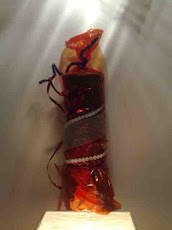

You will need a plastic bottle, one of the large types that are used for bottled water seems best, (the one in the photos is 4” / 10mm diameter) and several lengths of bamboo. If you or a friend have grown your own bamboo and have a few lengths that have been lying around for a period, then these are perfect; you can of course use other bamboo. You will also need some galvanised garden wire.
Tools required:
You will need a ‘Stanley’ type of knife, a saw, a pair of pliers that have a cutting section for the galvanised wire and a tape measure.
1. Cut the bottle to a convenient length, in the case illustrated it was at a ridge on the bottle that was about 6 ½” / 17mm from the end. 2. Make two small holes in the bottle that are in line with each other and around 2” 5mm from each end. 3. Cut two lengths of the wire about 18” / 46mm long and run the two ends of each piece through different holes, each on the inside the bottle circling them against the inner wall. 4. Cut your bamboo into lengths, in this case I cut them 7” / 18mm long, and push them into your container until it is full. 5. Twist the wire (but not too tightly, it can break) at the point where it emerges so as to lock the bamboo into place and again at the end in order to form loops. These are your fixings, and can be extended by other lengths of wire if needed. Test the construction by holding the open end down and shaking gently. If any canes fall out, put another one in.
The Hotel will need to be positioned preferably where it will not swing around and protected from the sun. The closed end pointing towards the prevailing wind in winter and pointing slightly down towards the open end so as to drain should any water enter.
Solitary bees often live in old mice nests; I have been reliably informed that they like the smell, so old canes that have been left on the ground and so have perhaps been the attention of our little furry friends will be ideal for them. Lacewings are fond of the colour red, if you can locate a red bottle they may prefer this.








